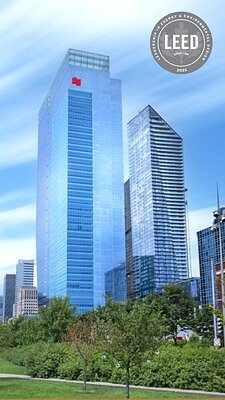
National Bank Place Sets New Standard for Sustainable Finance in Montreal
National Bank of Canada’s new Montreal headquarters achieves LEED Gold certification, showcasing a commitment to innovation, employee well-being, and a greener future for Canadian finance.
National Bank Place Sets New Standard for Sustainable Finance in Montreal
MONTREAL, QC – November 19, 2025 – National Bank of Canada’s newly completed head office, National Bank Place, has achieved LEED Gold certification for new construction, solidifying its position as a leader in sustainable building practices within the Canadian financial sector. The 40-story high-rise in downtown Montreal represents a significant investment in environmental responsibility and signals a broader commitment to long-term sustainability.
A Commitment Beyond Concrete and Steel
National Bank Place isn’t simply a modern office tower; it's a carefully designed ecosystem focused on minimizing environmental impact and maximizing occupant well-being. The building incorporates a range of innovative features, from clean energy use and advanced energy recovery systems to efficient materials like LED lighting and, notably, a triple glazing envelope – a first for a high-rise in Quebec. This combination of strategies resulted in achieving LEED Gold certification, a globally recognized mark of excellence in green building.
“This project was about more than just ticking boxes,” said one source close to the architectural firm. “It was about challenging conventional thinking and pushing the boundaries of what’s possible in sustainable design.” The incorporation of triple glazing, while adding to the initial cost, is expected to deliver substantial long-term savings through reduced energy consumption and enhanced thermal comfort.
Triple Glazing: A Quebec First and a Technical Triumph
The decision to employ a triple glazing envelope in the Quebec climate marks a significant departure from traditional construction practices. While common in northern Europe, it’s a relatively rare sight in Canada. “The benefits are clear – superior thermal performance, enhanced soundproofing, and increased security,” explained a building materials expert. “However, it does present logistical challenges in terms of weight and installation.”
The advanced glazing system is expected to significantly reduce heat loss during Montreal’s harsh winters and minimize solar heat gain during the summer months, lowering the building’s overall energy demand. The triple-pane construction also contributes to a quieter and more comfortable indoor environment for employees and visitors. The use of this technology highlights the bank’s willingness to invest in cutting-edge solutions that prioritize both environmental performance and occupant experience.
Beyond Certification: The Rise of Sustainable Finance
National Bank Place’s LEED Gold certification isn’t an isolated event; it’s part of a broader trend towards sustainable finance and responsible investing. Canadian banks are increasingly recognizing the importance of environmental, social, and governance (ESG) factors in their long-term strategies. This shift is driven by investor demand, regulatory pressures, and a growing awareness of the risks and opportunities associated with climate change.
“Investors are now actively seeking out companies that demonstrate a commitment to sustainability,” said a financial analyst specializing in green investments. “They understand that these companies are better positioned to manage risks and capitalize on emerging opportunities.”
Several other Canadian banks, including RBC and TD, have already made significant investments in green buildings and sustainable initiatives. RBC has a portfolio of LEED-certified properties totaling over 4.1 million square feet, while TD boasts over 100 LEED Gold or Platinum certified locations across North America. These investments not only reduce the banks’ environmental footprint but also enhance their reputation and attract environmentally conscious customers and employees. National Bank Place further exemplifies this trend, demonstrating the commitment of financial institutions towards a greener future.
The new head office also contributes to Montreal's broader sustainability goals. The building features a 40,000-square-foot urban park accessible to the public, contributing to the revitalization of the downtown core and providing a green space for residents and visitors. “The goal was to create a building that not only minimized its environmental impact but also contributed to the well-being of the community,” said a source involved in the project. The integration of green spaces and pedestrian-friendly features aims to create a more vibrant and sustainable urban environment for all.
The design prioritizes employee well-being, with abundant natural light, collaborative workspaces, and amenities like a gym, cafeteria, and daycare. These features are intended to create a stimulating and comfortable work environment, attracting and retaining top talent.
“We wanted to create a building that our employees would be proud to work in,” said a source within National Bank. “A space that promotes collaboration, innovation, and a sense of community.”
National Bank Place stands as a testament to the possibilities of sustainable design and a bold step towards a more environmentally responsible future for Canadian finance.
📝 This article is still being updated
Are you a relevant expert who could contribute your opinion or insights to this article? We'd love to hear from you. We will give you full credit for your contribution.
Contribute Your Expertise →